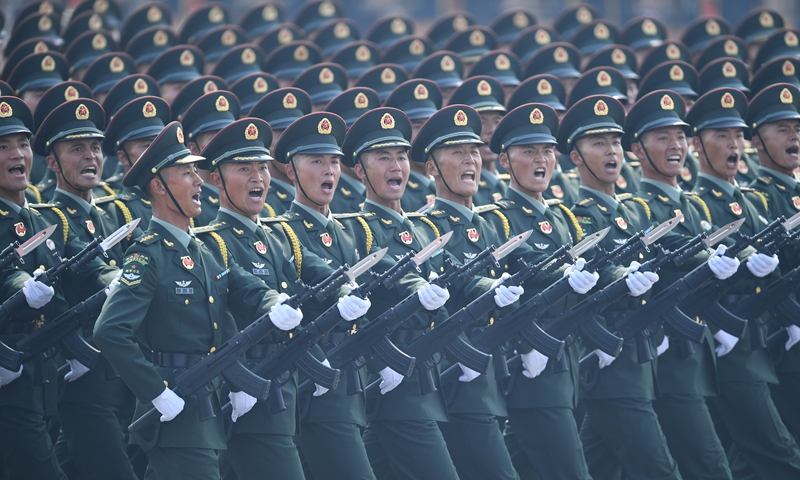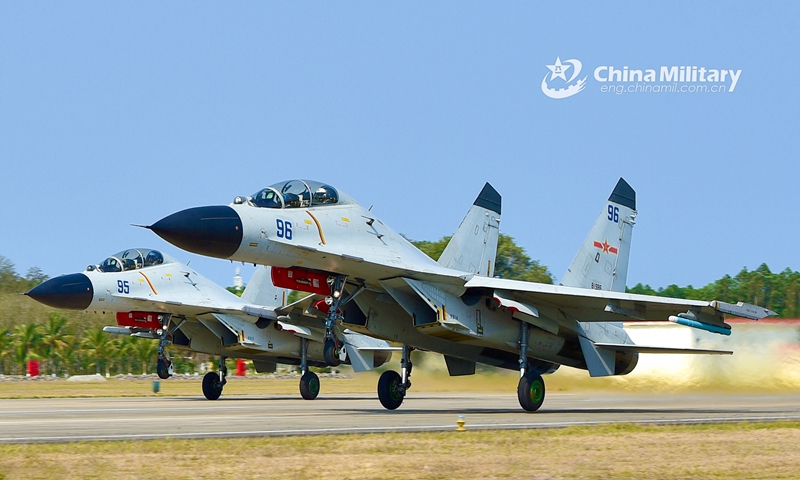
A formation of the People's Liberation Army (PLA) Army takes part in a military parade celebrating the 70th founding anniversary of the People's Republic of China in Beijing, capital of China, October 1, 2019. Photo: Xinhua
As a senior US military commander told lawmakers recently that China is "the greatest long-term strategic threat to security in the 21st century," though China has repeatedly said that it has no intention to challenge the US, Chinese experts warned Wednesday that such a hostile attitude held by the US military could increase the risks of conflicts in the region, and regional countries won't share US hostility against China.
Most countries in Asia hope to solve their sovereignty disputes with China, if any, through negotiations, but the US is an outside force trying to further militarize the region and interrupt the peaceful solution of regional issues, so US decision-makers should realize that it is the US, not China, that is the troublemaker, said analysts.
China, whether for its own development and sovereignty or the peace of the region, should further reinforce its military power to deter any foreign intervention that threatens regional stability, experts said.
"I worry they're [China] accelerating their ambitions to supplant the United States and our leadership role in the rules-based international order," Admiral Philip Davidson, Commander of US Indo-Pacific Command, said before members of the Senate Armed Services Committee, according to the VOA on Tuesday.

Two fighter jets attached to a naval aviation brigade under the PLA Southern Theater Command prepare to take off in alongside formation during a 2-day continuous flight training exercise from February 24 to 25. Multi types of fighter jets participated in the flight training mission which included various offense and defense operations. Photo:China Military Online
Unwelcome leadershipLü Xiang, an expert in US studies with the Chinese Academy of Social Sciences (CASS) in Beijing, told the Global Times on Wednesday that this is the same mentality as seen in the Obama era, and there is nothing more China can do to ease this kind of concerns, no matter how hard we have tried to explain, as they only care about our capability instead of our intentions.
Since Davidson mentioned "the rules-based international order," US leaders should remember that they don't even sign the UN Convention on the Law of the Sea, and they have no legitimate excuse to interfere in issues between China and other regional countries, said analysts.
"It's a misconception to think China is trying to supplant US leadership. The reason why US military officers and politicians have such a feeling is that the previous administration headed by Donald Trump abandoned their leadership in many fields, and now, they want to return but found many countries, and even their allies, are accepting China's solutions to many problems," Lü said. "China didn't force the US to leave. We welcome the US to play a constructive role in the region.".
Some countries in the region that have sovereignty disputes with China are also US allies. Now, they prefer to solve the problem with China through dialogue. They're aware that the US is "the real troublemaker" that always tries to incite unnecessary frictions and conflicts between them and China, and use these conflicts to contain China and let these countries pay the price. They don't want to be used anymore, experts said, and this makes the US feel that its leadership has been shaken.
Unfortunately, the US doesn't want to play a constructive role and will keep being provocative, because the region is so important for it to maintain its hegemonic influence, and the Asia-Pacific or Indo-Pacific region is becoming its strategic priority, Jin Canrong, associate dean of the School of International Studies at the Renmin University of China, told the Global Times on Wednesday.
"Since it has identified China as 'the greatest threat,' its military operations to provoke China in the South China Sea, Taiwan Straits, and even the use of its partners or allies like India and Japan to create more tensions with China, will increase the risk of military conflicts in the region," Jin said.
A powerful stabilizerIn the past century, when China had very weak military power and was unable to protect itself, the flame of war was everywhere in the Asia-Pacific region. And with the growth of China's military power and regional influence after 1949, the region has been getting more and more stable, said Chinese experts, noting that a powerful
Chinese military that is able to deter external military interventions is not only a "shield" for China, but also a "stabilizer" for regional peace.
While attending a plenary meeting of the delegation of the People's Liberation Army and People's Armed Police Force at the ongoing fourth session of the 13th National People's Congress, China's top legislature, on Tuesday, Chinese President Xi Jinping highlighted the "instabilities" and "uncertainties" in China's current security circumstances, the Xinhua News Agency reported on the same day.
Song Zhongping, a
Chinese military expert and TV commentator, told the Global Times on Wednesday that the "instabilities" and "uncertainties" mainly stem from the US, which has been interfering in China's internal affairs, including the Taiwan question, while also stirring up trouble in the South China Sea.
Over the past year, the US sold multiple batches of weapons, including those offensive in nature, to the island of Taiwan and sent warships through the Taiwan Straits repeatedly. US warships also trespassed Chinese territorial waters in the South China Sea many times, with aircraft carriers conducting several provocative exercises in the same region. US military aircraft were frequently spotted near China's coastal regions for apparent close-in reconnaissance operations.
Xi said the Chinese armed forces must always be ready to respond to all kinds of complex and difficult situations, resolutely safeguard national sovereignty, security, and development interests, and provide strong support for fully building a modern socialist country.
China needs to continue to strengthen its military to carry out these missions under the pressure of external threats and out of the rightful demands, as China continues to develop economically, analysts said.
Laying emphasis on achieving a good start in strengthening national defense and the armed forces during the 14th Five-Year Plan (2021-2025) period, Xi said at the plenary meeting that development of the armed forces must focus on combat readiness, and he called for intensified efforts and more concrete measures in the pursuit of independent innovation in science and technology, to fully leverage the role of science and technology as the strategic support for military development.
Song said that the development goal of the Chinese armed forces is to be ready for combat.
Lü from CASS said as long as China continues to strengthen its capability for combat readiness to deter external military threats, and insist on a peaceful development strategy, the possibility of war with the US will remain low. "The peace would be reliable and sustainable when combat readiness is accountable," he said.
Be preparedThe
Chinese military announced in February that it would build a new type of training system that would improve military training in all respects, strengthen the capability to win wars and build the
Chinese military into a world-class one.
In addition to training, China will also reach another new level in weaponry and equipment development in the next five years, Song said, noting that the 14th Five-Year Plan period will prepare for the 100th anniversary (in 2027) of the founding of the people's armed forces by reaching mechanization, informatization and intelligentization.
A large number of advanced weapons and equipment will be developed and commissioned during the period, and will even surpass the achievements reached in the past five years, Song predicted.
China is reportedly
building its third aircraft carrier which is widely expected to be much larger than the country's previous two, and to feature newly developed electromagnetic catapults. Analysts predict it could be launched in one or two years and enter service by 2025.
The long-expected
H-20 long-range stealth bomber could also make its debut soon, as analysts expect the nuclear-equipped aircraft to form a formidable, high-caliber strategic deterrence like the US' B-2 bomber.
Other additions to the
Chinese military's arsenal could include next-generation aircraft carrier-based stealth fighter jets, warship-mounted electromagnetic rail guns, Type 09V nuclear-powered attack submarines and Type 09VI nuclear-powered ballistic missile submarines, analysts said.
Avoiding casualties will become standard for future warfare, and wars could be fought by unmanned weapons as technologies develops, Song said, noting that China should increase investments in related equipment to make sure its military is up to the requirements.





